Content
Among the heavy meat and greasy breeds of geese, the Kholmogory breed of geese stands out for its unpretentiousness to conditions of detention and a peaceful disposition. Relatively peaceful, of course. The gander will always protect his family, no matter how peaceful he may be.
Kholmogory geese were bred by crossing the Chinese and Arzamas geese breeds. But this is only one of the versions. The most common.
Since the Kholmogory geese are one of the oldest breeds, one cannot be 100% sure of the correctness of the only version of the origin of the breed. At least today at Kholmogorskaya goose breeds 2 lines stand out:
- large birds with a long, humped beak. A drooping feather is sometimes observed on the wings of these geese;
- geese with short or medium length beaks.
When breeding the first group, most likely, the Tula fighting geese were used, in which the drooping of feathers on the wings, a large beak and a large weight are the norm.
In the ancestors of the second line, common gray and Chinese geese were noted.
Although, perhaps, these are already later influxes into the breed, since it is unknown even called the Kholmogory geese at the place of their breeding or at the place of distribution.
The first documentary mentions of this breed date back to 1885. Over the decades of breeding Kholmogory geese, many lines appeared and disappeared in the breed, until today only the indicated two remain.
Description of the breed of Kholmogory geese
Kholmogory geese are very large birds. The weight of a gander can reach 12 kg, and a goose - 8 kg. A distinctive feature of the Kholmogory breed geese is the bump above the beak, which reaches its full size in the 5th year of the goose's life; a very large dewlap under the beak, which is sometimes called a purse; two fat folds on the abdomen. The body is wide, massive with a well-developed chest. The beak and legs are orange. The photo clearly shows the bump, "wallet" and folds on the belly.
The color of Kholmogory geese can be gray, white or gray-piebald.
Kholmogory geese have the ability to quickly adapt to life in a large herd, which is largely facilitated by their calm nature.
Productive characteristics of the breed
There are no complaints about the production of meat and fat to the Kholmogory geese. Already in a little over 2 months, the goslings of the Kholmogory breed are gaining weight from 4 to 4.5 kg. There are serious claims to the Kholmogory people for the production of eggs.
Kholmogory geese reach full development only by the age of 3 years. At this age, the fertilization of eggs in the Kholmogory breed reaches 80%. The goose lays only 30 eggs per year. The weight of an egg in a young goose is 140 g, in a three-year-old - 190 g.
It helps the geese that they are centenarians. The life expectancy of the Kholmogory people is about 16 years.
Maintenance of the Kholmogory people
Geese of the Kholmogory breed tolerate frosts well if there is a properly equipped poultry house. Their main requirements for a winter shelter are: good ventilation, no drafts and a dry floor. Drafts are the most dangerous for Kholmogory residents.
During the winter, all the cracks are closed in the goose-house, and a thick layer of straw is laid on the floor. In summer, birds can easily get by with a canopy from the sun.With the onset of rains and winds, the perimeter of the frame, on which the canopy is attached, is covered with plastic wrap or roofing material.
Therefore, from the inside, it is better to first pull the fine mesh netting.
Sawdust or straw / hay cuttings can also be used as bedding. But we must remember that a hungry bird can begin to eat bedding. In summer, geese graze on their own, and in winter they must always have access to food, which additionally performs a warming function in winter.
The birds are not afraid of frost, but the lack of food. It is not for nothing that primordially migratory birds, such as swans and ducks, nowadays more and more often remain to winter on non-freezing water bodies in cities. Why waste energy and fly somewhere if the townspeople provide food. In geese, the situation is similar. A thick layer of bedding will keep their paws from frostbite, and the food in the trough will keep them from freezing.
It is the owner's job to ensure that the litter is always dry. Geese have runny droppings that will make the litter wet. Wet spots are removed and fresh litter is poured in their place.
If this rule is not observed, the structure of the feather deteriorates in the bird from ammonia fumes. Feathers become tousled and no longer warm.
The area of the house is calculated on the basis of 1 m² per head. But it should be noted that this is a place to spend the night. One goose needs 5-6 m² for walking.
Feeding the Kholmogory people
The diet of geese includes grain feed, finely cut roots, greens. Chalk and fine gravel or crushed stone must be kept separately.
In winter, 160 g of compound feed, 150 g of grass flour, 500 g of chopped root crops are given per head. Vitamin and mineral premixes are mixed into the feed.
In summer, Kholmogory residents are driven out to graze in the meadow. An adult goose eats up to 2 kg of grass per day.
Breeding of the Kholmogory breed
Kholmogory geese are good brood hens, but despite this, the percentage of hatched goslings is very low. There are several reasons for this.
- For better fertilization of geese, a few geese should be left in the herd. One is not enough.
- The larger the gander, the harder it is for him to fertilize the goose, and the size of the offspring does not depend on the size of the gander. Therefore, it is better to leave small males for breeding.
- Kholmogory geese have a very large weight and often they just crush the eggs.
- Oddly enough, but it interferes with the fact that Kholmogorki are good hens. They rarely leave the nest, thus preventing the eggs from cooling properly. Periodic cooling and moistening of the eggs is necessary for the normal development of the embryos.
According to the totality of all factors, hatchability of goslings in Kholmogory is only 60%.
You can also breed Kholmogory by incubation. True, the same cooling and humidification factors are present here. In an incubator, it is quite difficult to achieve 70% humidity, which is necessary for the normal development of the embryo.
The incubation period of goose eggs is 30 days at a temperature of 37.9.
Incubation errors:
Raising ducklings
Kholmogory ducklings are picky about food. They can be fed with starter feed for poultry chicks or cook them yourself.
On the first day of life, the goslings are not fed, as they continue to assimilate the egg yolk. The countdown of the days of feeding begins from the second day of the goslings' life.
When self-cooking, the first two days, the goslings are given a chopped boiled egg and ground grain. Later, cottage cheese, cake, chopped grass are gradually added.
This phenomenon can be avoided when feeding with factory dry compound feed. In this case, you just need to make sure that the goslings always have water.
From one week of age, goslings can already be released into the meadow together with an adult bird.
Determination of the sex of goslings:
Reviews of the owners of Kholmogory geese
Conclusion
Kholmogory geese are beneficial in those regions of Russia where there is a lot of water and green grass all summer. In this case, the bird gets its own food and costs the owner very cheap. You have to feed only the broodstock and only in winter.
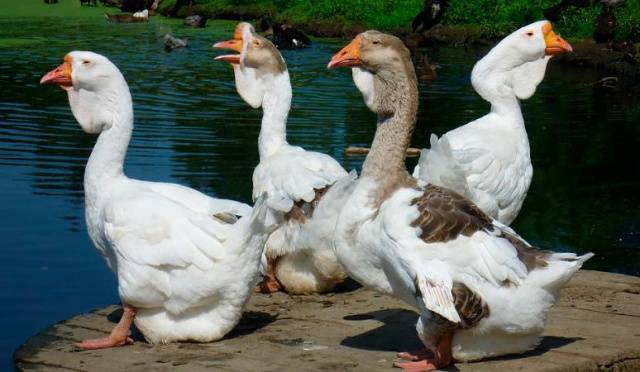
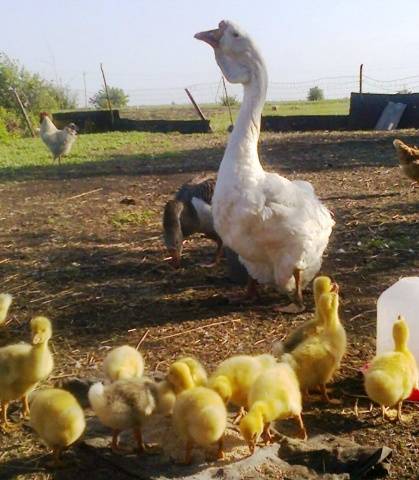
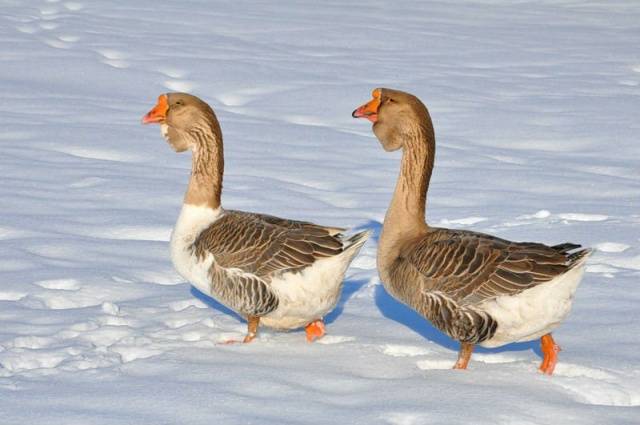
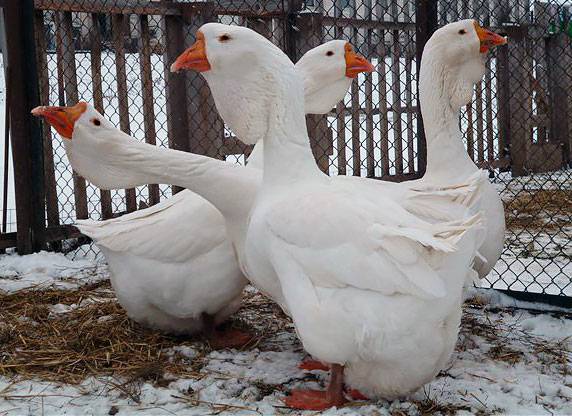
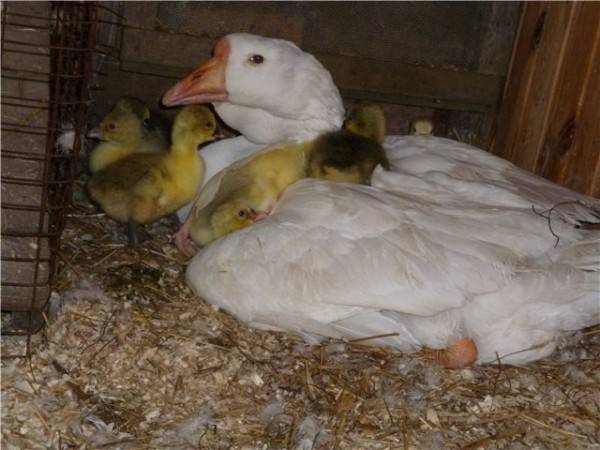
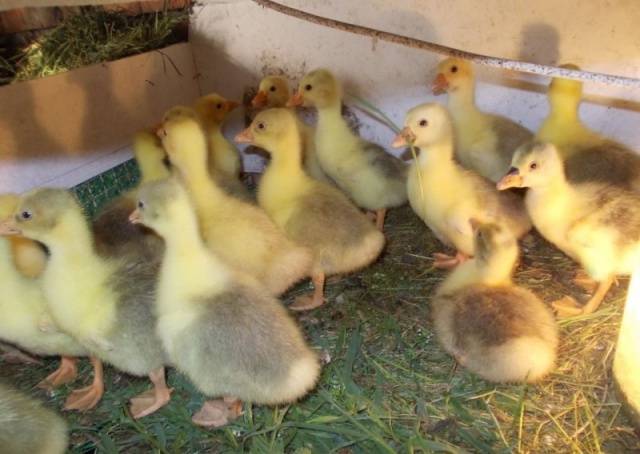









Tell me please, I heard that if you incubate eggs at home, after hatching, the goslings will need to be patted and pierced with some expensive drugs, is this so or not? And what exactly! Thanks for the info!